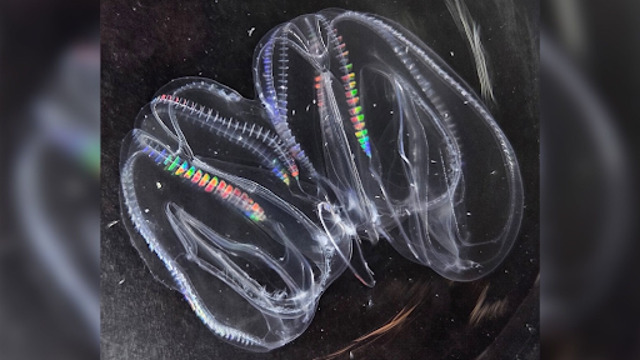
Research has found that comb jellies, or Mnemiopsis leidyi, not only merge their bodies but also combine their nervous and digestive systems. CNN
In a groundbreaking discovery, scientists at Woods Hole Oceanographic Institution have revealed a remarkable biological phenomenon: two comb jellies merging into one. This fascinating event was witnessed in late summer 2023 by Kei Jokura, a marine biologist who noticed that two jellies, when placed together, fused into a single organism. The findings could have major implications for our understanding of biology.
Jokura, a postdoctoral researcher at the University of Exeter, was studying the behavior of Mnemiopsis leidyi, a species of comb jelly, when he first observed the fusion. He quickly rushed to share his findings with Mariana Rodriguez-Santiago, a fellow researcher at Colorado State University. Both were astounded to see that the two creatures were not only physically combined, but their nervous and digestive systems had merged as well.
“We were all amazed and astonished, thinking, ‘How can they fuse and still be swimming and moving around like a unit?’” Rodriguez-Santiago recalls. Intrigued by this, she gently prodded one jelly with a pipette. To their amazement, the jelly moved, and the second jelly, seemingly attached, moved in synchrony. “We thought, ‘Are they able to feel the same thing? Are they one individual? Two individuals? How can we disentangle this?’” Rodriguez-Santiago said, puzzled by the behavior.
The researchers, determined to understand the fusion process, continued experimenting by joining more pairs of comb jellies. They found that the fused jellies not only shared physical traits like their sensory organs but also merged their digestive systems. This fusion allowed the two animals to function as a single unit, each contributing to the digestion process. This discovery was published in the journal Current Biology on October 7, 2023.
Jokura, now a postdoctoral researcher at Japan’s National Institute for Basic Biology, highlighted that the discovery challenges our understanding of biological concepts. “The fusion phenomenon has definitely brought up many interesting questions, such as which genes are involved in fusion, what happens to neural signaling, and what defines ‘self’ and ‘nonself,’” he said. These findings could open new avenues for studying the flexibility of biological systems, especially in simpler creatures like comb jellies.
Comb jellies, or ctenophores, are found all over the world, both in coastal waters and the deep ocean. These ancient animals, which date back to the very beginnings of animal evolution, provide an ideal opportunity to study nervous system function. Unlike jellyfish, comb jellies don’t sting and have distinctive rows of cilia (hair-like structures) that they use to move.
Rodriguez-Santiago noted that ctenophores, as some of the oldest animals, offer a unique chance to explore fundamental biological concepts. "They belong to a group of animals which were there when the very first animals evolved,” she said. These creatures’ ability to adapt quickly to changing environments is one reason why they are so fascinating.
The fusion process could also be a survival mechanism. Jokura’s research suggests that ctenophores lack an allorecognition system—the ability to distinguish between their own cells and foreign cells—which typically helps organisms protect themselves from diseases. By bypassing this, ctenophores may have an advantage when it comes to survival in challenging conditions.
Through time-lapse imaging, the researchers were able to observe how the fused jellies synchronized their movements and digestive processes. Even when fed, the digestive systems worked in unison, and food particles traveled across the fusion boundary. Waste was then expelled through separate openings, each at different times, demonstrating the level of integration achieved through fusion.
Looking ahead, Jokura plans to further investigate how the jellies' nervous systems integrate following fusion. “By visualizing neural networks, we might be able to explore something like the fusion of consciousness,” he said, intrigued by the possibility of studying how two organisms might function as one.
This discovery not only deepens our understanding of comb jellies but may also provide crucial insights into the evolution of nervous systems and how simple organisms adapt and survive.















